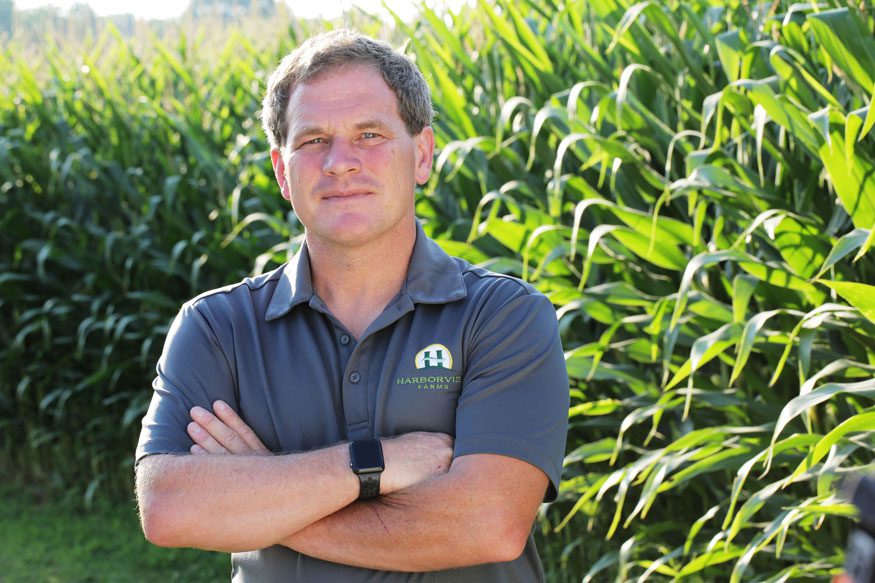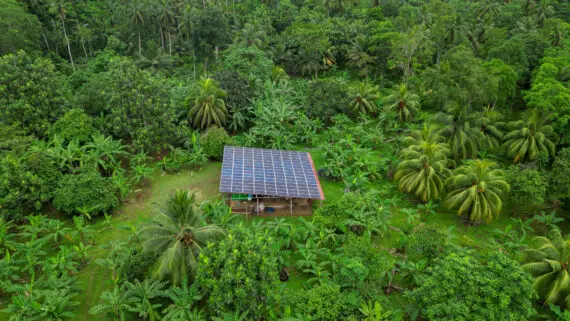This story is featured in the 2020 Hunger Report: Better Nutrition, Better Tomorrow
As the owner and manager of Harborview Farms, Trey Hill is a third-generation family farmer on Maryland’s Eastern Shore. Along with his father, Herman, and a small team of employees, Hill raises corn, soybeans, and wheat on more than 13,000 acres situated alongside the Chesapeake Bay. This makes Harborview Farms one of the largest agricultural operations in Maryland.
But Hill is known for much more than the size of the farm. His reputation as a leader in transforming and reorienting U.S. agriculture to climate change has spread beyond his home state.
In 2018, Harborview Farms was named the first Forward Farm in North America by Bayer, one of the largest agribusiness companies in the world, headquartered in Germany. Forward Farms are selected “to foster understanding about today’s sustainable agriculture practices, not to promote any single company.” Harborview Farms is one of only 14 farms to receive this honor. The others are located in Europe and Latin America, growing crops ranging from feed grains to wine grapes.
Hill has been doing as much as anyone to help fellow farmers see themselves as part of the solution to climate change rather than scapegoats in an unfair blame game. There are simple things that farmers can do to deal with climate change that don’t cost them any additional expense, such as “no-till.”
Typically, after crops are harvested in the fall, farmers plow their fields or leave them fallow until the next planting season. What agricultural science has taught Hill and other farmers is that it is better not to plough. Letting the soil rest has made Hill’s fields more tolerant of the hard rains and dry conditions that climate change has intensified.
Only 20 percent of agricultural land in the United States uses this “no-till” practice. The environmental benefits are huge because soil stores carbon, and the less the soil is disturbed by ploughing the more carbon it pulls from the atmosphere, reducing one of the main greenhouse gases responsible for climate change. If enough of the world’s farmers used no-till—combined with emissions reduction from burning less fossil fuel—it would substantially slow the progress of catastrophic climate change substantially, and even begin to reverse it.
Hill also uses what are known as cover crops on his fields. Following a harvest in the fall, he and his employees cover the fields with rye, barley, clover and radish seeds. As these crops grow over the winter and into spring, it improves the soil quality. “The soil likes to thrive,” says Hill, “—just like people.”
Crops that are blanketed in healthy soil contain more nutrients. Setting aside the environmental and nutritional benefits, healthier soil increases his corn, soy, and wheat yields—the crops that generate the farm’s income. Healthier soil also mean he doesn’t have to spend as much on fertilizer, herbicide, or other chemicals to achieve strong yields. “It’s not perfect,” he says, noting it doesn’t lead to the elimination of chemical inputs, “but it’s a lot better than we were doing before.”
Planting cover crops is still an unconventional technique for most U.S. farmers, and that’s why the number of farmers who use cover crops is much lower than those who’ve switched to no-till. Hill admits it’s a challenge to get farmers to change, “If you’ve been farming one way for decades and been having success, there isn’t a lot of incentive to change.”
Farmers on the Eastern shore of Maryland had incentive to change. The state government pays farmers up to $90 per acre to plant cover crops. Pollution in the Chesapeake Bay from farm run off was contaminating ground water and harming the seafood and tourism industries. It was also a political embarrassment as the Bay was considered an ecological disaster.
While only about 4 percent of cropland nationwide uses cover crops, it is around 50 percent in Maryland. Maryland had a crisis and state leaders were willing to act to prompt farmers to change how they do business. Climate change under business as usual scenarios augur tall challenges for food systems everywhere. “We’re going to have to change the way we grow food,” says Trey Hill.
“We’re going to have to change the way we grow food”



